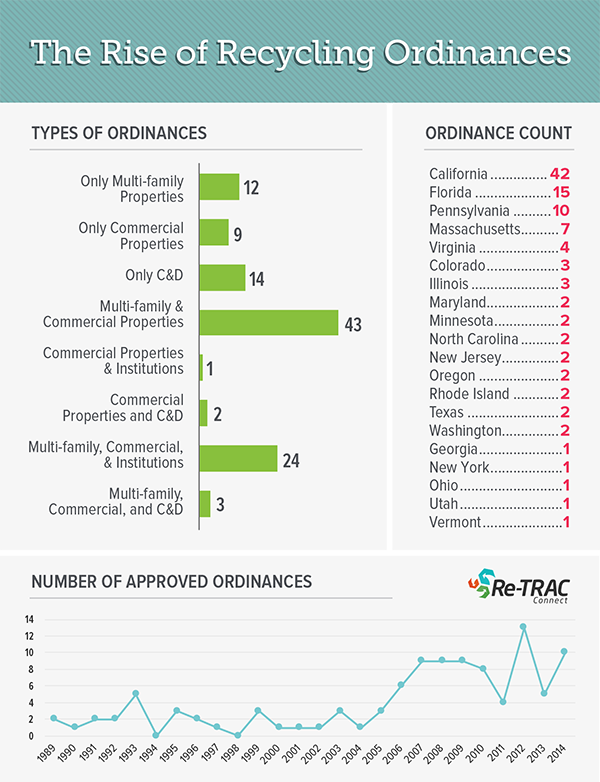The Rise of Recycling Ordinances

An increasing number of local governments in the U.S. are implementing mandatory recycling ordinances that target commercial and/or multifamily properties, and can also extend to institutions and C&D projects. We researched local government recycling ordinances implemented across the United States since 1989 to look for trends in the data. Since 2005, mandatory recycling ordinances have tripled in the U.S. They are viewed as an effective tool to increase diversion from the Industrial, Commercial, Institutional sector and help municipalities achieve zero waste goals.
In April, we profiled Austin Resource Recovery (ARR) and identified the key elements that contribute to a successful Universal Recycling Ordinance (URO). Using Austin Resource Recovery as our example, let’s review those elements again:
1. Clearly defined goal:
The City set out to achieve Zero Waste by 2040 which means keeping at least 90 percent of discarded materials out of the landfill.
Setting a clearly defined goal ensures that all stakeholders understand the intended purpose of the recycling ordinance and the role it plays towards achieving the goal.
2. Strategic plan:
Supported by two years of research, stakeholder engagement, and community input, ARR’s Master Plan sets the stage for the Department’s programs and services for the next 30 years and beyond.
The strategic plan is the road map that guides all stakeholders toward the final destination: your goal. The plan should clearly describe roles, responsibilities, available services & resources, and how the mandatory recycling ordinance fits into the strategy.
3. Support:
The ARR team offers site visits, consultations, assistance with setting up new collection programs, and proven strategies to increase the impact of existing programs. They also offer online tools to help property owners comply with the ordinance including: capacity calculators, downloadable bilingual posters and signage, and online reporting to submit Annual Diversion Plans.
Recycling ordinances must have a solid support system in place to be successful. With the right level of education, resources, and support services, the strategic plan will inspire the community and encourage a collaborative approach to achieving waste reduction targets.
The Research
Now that we have looked at what’s needed to implement a successful recycling ordinance, let’s have a look at the numbers. Earlier this year, we conducted research to learn more about recycling ordinances in the U.S. With a focus on multifamily, commercial, institutional, and C&D ordinances, our research shows that recycling ordinances are on the rise.
The majority of local governments favored multifamily and commercial ordinances but C&D ordinances also showed strong numbers. The data also revealed a heavy presence of ordinances in California, Florida, and Pennsylvania.
As previously published in the May 2016 edition of the Resource Recycling Magazine, this graphic describes the results of our research:

The Ultimate Guide to Writing a Mandatory Recycling Ordinance
MAY 3, 2017 at 1PM EST / 10am PST
Register to attend by clicking the “REGISTER” button below. All attendees will receive a free Roadmap to Mandatory Recycling Planner.